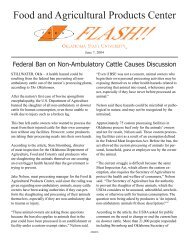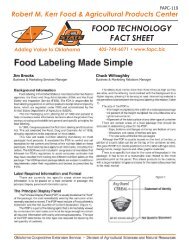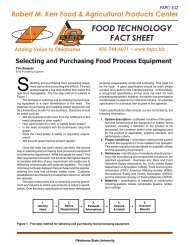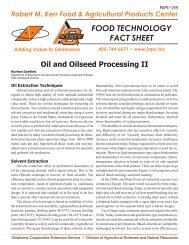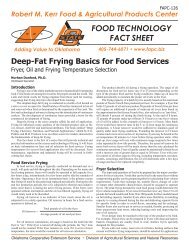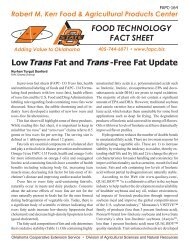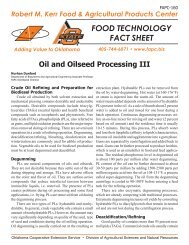Spring/Summer 2010 - Robert M. Kerr Food & Agricultural Products ...
Spring/Summer 2010 - Robert M. Kerr Food & Agricultural Products ...
Spring/Summer 2010 - Robert M. Kerr Food & Agricultural Products ...
You also want an ePaper? Increase the reach of your titles
YUMPU automatically turns print PDFs into web optimized ePapers that Google loves.
processed at a loss of only fifty cents<br />
per unit. If the loss per unit is cut in<br />
half, and the savings are passed on to<br />
the customer, even more units can be<br />
sold.<br />
The result was increased production,<br />
but margins continued to be thin,<br />
missing, or minus. By today’s standards,<br />
this is not a sustainable marketing<br />
strategy.<br />
According to the American Marketing<br />
Association, “Marketing is the<br />
activity, set of institutions, and processes<br />
for creating, communicating,<br />
delivering, and exchanging offerings<br />
valuable to customers, clients, partners,<br />
and society at large.”<br />
Thus, it is a system to add value<br />
by increasing customer awareness and<br />
delivering differentiated products and<br />
services. Having a marketing plan can<br />
lead to increased margins for small<br />
and large producers and can be a winwin<br />
for processors and end users.<br />
It is not unusual that about 80<br />
percent of the margins result from sale<br />
of about 20 percent of the products.<br />
Remember the “80/20 rule?”<br />
In the example above, volume and<br />
low price did not result in significant<br />
margins. Therefore, the business-marketing<br />
strategy shifted toward reducing<br />
the commodity side (80 percent) of the<br />
business and increasing the processed<br />
side (20 percent), or to shift product<br />
mix from commodities to consumer<br />
branded products. To shift away from<br />
commodity products, marketing gurus<br />
were hired and given the assignment<br />
to “work their magic.”<br />
The marketing gurus began by<br />
hosting a series of endless meetings to<br />
plan, develop, and sell the new strategy.<br />
The result was a plan to expand<br />
existing brands with new products,<br />
create new brands, and phase out commodity<br />
products, where possible.<br />
My role was to keep a steady<br />
stream of new or redesigned products<br />
in the pipeline to meet marketing objectives<br />
and help keep the gurus employed.<br />
The marketing gurus expected<br />
new products to fit a customer need<br />
(perceived or real) and meet specific<br />
financial targets.<br />
In most cases, actual product development<br />
did not take place until a<br />
financial analysis was conducted. Market<br />
research became<br />
part of the package<br />
and was used to<br />
determine what consumers<br />
would like<br />
and if specific features<br />
were of interest.<br />
Focus groups<br />
were conducted to<br />
test proposed concepts,<br />
product acceptance,<br />
and interest in purchasing.<br />
Information learned through market<br />
research was used to support new<br />
product development and presentations<br />
to buyers. It provided reasons<br />
why buyers should stock the new and/<br />
or revised products.<br />
During time, a paradigm shift took<br />
place within the sales force as marketing<br />
plans expanded beyond volume<br />
and price.<br />
The customer now became part of<br />
the equation. Sales personnel relied on<br />
features and benefits including “price”<br />
as a factor, but not the only factor to<br />
consider when selling product.<br />
On time delivery, accurate invoicing,<br />
credits, product support, and marketing<br />
allowance were non-product<br />
features used to differentiate products<br />
from the competition and support<br />
buyer satisfaction.<br />
Operating according to Dilbert, “If<br />
you lower the price, you can sell more<br />
food processing<br />
By David Moe<br />
FAPC Pilot Plant Manager<br />
david.moe@okstate.edu<br />
units, or if you increase the price, you<br />
will sell fewer units” slowly became<br />
a concept of the past. The new strategy<br />
of adding value to products and<br />
services continued after the marketing<br />
gurus moved on.<br />
Marketing is a way of offering<br />
“something,” a competitive product<br />
not offered in another market. This<br />
brings to mind the story of a new store<br />
opening next door to compete with an<br />
existing store.<br />
The new store put up a sign saying,<br />
“best deals.” When another new<br />
store opened on the other side of the<br />
original store, they put up a sign saying,<br />
“lowest prices.” When sales at the<br />
original store dropped, they put a sign<br />
over its door saying, “main entrance.”<br />
Of course, this is not a true story,<br />
but shows how a “marketing plan” can<br />
deliver the customer to your product,<br />
at least short range.<br />
When customers expect only low<br />
price, they move on if price does not<br />
meet their target. However, if price,<br />
quality, and service all exceed their<br />
expectations, they will soon learn the<br />
“best price” is not always the lowest.<br />
Having a well thought out brand<br />
and marketing strategy, is part of a<br />
system to identify, keep, and satisfy<br />
the customer. Another part of the system<br />
is to provide consistent products<br />
and services.<br />
In a nutshell, “why marketing?”<br />
<strong>Spring</strong>/<strong>Summer</strong> <strong>2010</strong> | 21



